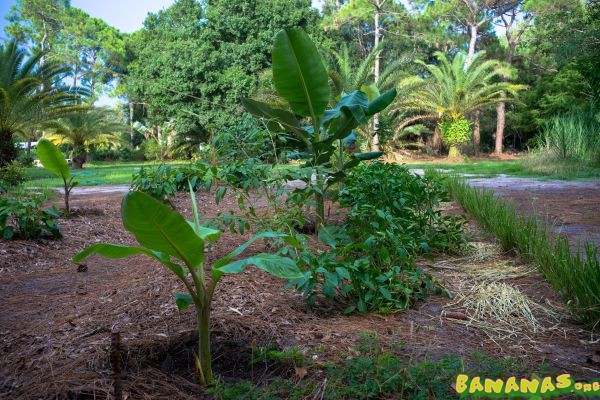
I had been almost too young to even remember the last time that bananas had grown on my parents' farm, the Manzanos that had volunteered in the compost pile and been divided to supply our household needs and the Cavendish before them (I still don't know the type other than that it wasn't a dwarf). The Cavendish preceded my parents' involvement in this property and were an addition to the acreage by way of some Jamaican men who helped the prior tenants farm hogs here.
I have memories of going to dig banana suckers to maintain these plantings--part of my farm responsibility as a kid--and having to use the shovel to kill rattlesnakes and coral snakes instead. The more I think of it, the more I wonder how the Manzanos managed to grow in ten hours of deep bamboo shade.
It wasn't until I began embarking on the long road to reclaiming the neglected part of the farm that had once contained the Cavendish that I found one small mat of them still standing, the lone mother stem that is pictured above, rising above the morass of Sorghum halepense, Momordica charantia, Ficus aurea, and others. A sword sucker has begun emerging from the mat since I began rooting out the invasives and is piercing through one of the original signs of our farm, rotten almost beyond recognition.
Before this discovery, I would have estimated that it had been seventeen years since a banana had grown here. And despite the fact that my family and I have grown organic produce for sale to the public since 2010, one of the world's great food staples had not been a part of what we grew.
With the inspiration of a friend who haunts Tropical Fruit Forum, last fall I began roughing in several areas within the landscape with the purpose of rotating bananas through them. The land for the first of these plots sat cover-cropped with Sorghum-Sudan, Crotalaria juncea, and several types of pea until the spring, when I laid out the rows, ran irrigation, and finished hardening off the first of the tissue cultures. What follows are pictures of the progress since the beginning of May, as everything stands on August third.

From left to right, foreground to background (what's visible): Pisang Raja, FHIA-17, Morado, A'ea'e, Pisang Ceylon, Brazilian, Orinoco, African Rhinohorn, SH-3640, Viente Cohol. Thanks, Nick (Nicolas Naranja), for the recent addition of the Morado. Super-big thanks to Dan (bananimal) for the additions of the A'ea'e, Pisang Ceylon, SH-3640, and Tori loquat!


In the foreground: A Kandrian that wasn't visible in the previous two photos.


In the far background: FHIA-3 is neighbors with the Pisang Raja previously pictured, and moving right, you'll find another VC. To the right of that and outside of the frame is a Gros Michel.
Still to be planted in this area, to the northwest, are Saba; Manzano; more Gros Michel; more SH-3640; and the French Red, Tigua, and Patupi that just arrived from Keith (PR Giants).
I've learned a great deal in my relatively short time following this site. Thank you all for making this place as valuable a resource as it is. I leave you with a shot of the rain falling on one of our herb gardens, filled now primarily by a Seminole pumpkin volunteer, but also occupying Ocimum tenuiflorum, Plectranthus amboinicus, Andrographis paniculata, and Levisticum officinale.

(For full-size photos in better quality, go here:
https://goo.gl/photos/fNRNxxtFSvQ4iL6W9 .)
Nathaniel